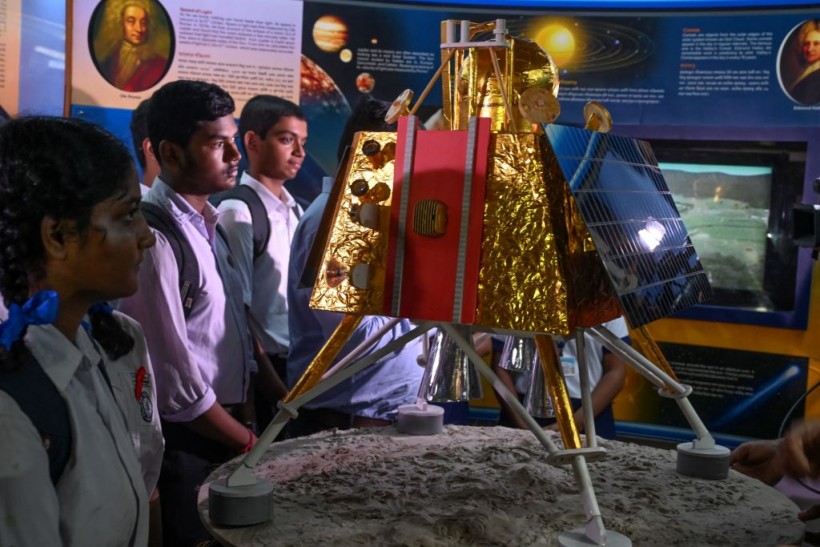At the beginning of this week, India achieved the distinction of being the fourth nation to successfully land on the Moon, marking a significant milestone in space investigation. The Vikram lander from the Indian Space Research Organization (ISRO) accomplished another historic feat by becoming the initial spacecraft to make a landing near the Moon's southern pole.
This presents an enticing prospect to study an area on the Moon suspected to contain substantial water ice, thus positioning it as a crucial area for forthcoming initiatives aiming to establish a lasting presence on the lunar surface.

School students look at a model of Chandrayaan-3's Lander Module (LM) named as Vikram, at a technical museum in Kolkata on August 23, 2023.
Pragyaan Rover Touches the Lunar Surface Via a Ramp
As the Chandrayaan-3 mission successfully lands on the Moon's south pole, citizens of the most populous nation's inhabitants gathered around TV screens in workplaces, stores, and eateries and erupted into applause, dances, and the exchange of sweets, as they witnessed the flawlessly executed landing of the lander.
Ajay Bhargava, an architect based in New Delhi, expressed his delight in observing the landing broadcasts, perceiving it as the culmination of years of dedicated efforts by India's scientific community.
ISRO Chairman S. Somnath highlighted that the lander achieved its touchdown near the heart of the targeted 4.5-kilometer-wide area. As per Press Trust of India, he stated that the lander's placement was within a mere 300 meters (985 feet) of the designated point.
ISRO recently shared two videos of the lander, capturing the remarkable landing sequence. The first video showcases Vikram's deployment of the Pragyaan rover, a six-wheeled vehicle weighing 57 pounds, onto the lunar terrain.
Named after the Sanskrit word for "wisdom," Pragyaan is tasked with investigating the region for indications of ice. The second video displays Vikram's smooth traversal across the surface, marked by numerous craters.
This remarkable achievement signifies the dawn of a fresh chapter in global space exploration. As history has shown through numerous unsuccessful endeavors, orchestrating a gentle spacecraft landing on the lunar landscape is an exceptionally intricate task; and India has achieved this feat flawlessly. Chairman Somnath remarked that the rover's mobility was commendable and that it was functioning "very well."
New Age of Space Race
The recent success of India arrives after Russia's unfortunate endeavor to land its Luna-25 spacecraft on the Moon, resulting in a catastrophe during the past weekend. The spacecraft's collision with the lunar surface occurred due to an unforeseen emergency, thwarting Russia's aspirations to continue the trajectory of the Luna missions initiated by the Soviet Union, tracing their origins back to the 1970s.
In the forthcoming stages, India's mission could conclusively validate a theory that scientists have harbored for a considerable time: the potential existence of substantial water reservoirs within the Moon's rough polar regions, especially within the obscured recesses of its extensive craters.
Vikram's successful landing might signify the initiation of a fresh phase within the ongoing space competition. As the United States and China advance their lunar exploration agendas, India's accomplishment has now positioned it significantly within the upcoming endeavors to establish a lasting presence on the Moon, potentially reshaping the global dynamics of this celestial body.
Furthermore, the prospect of additional nations entering the scene appears promising. Japan's space agency, JAXA, is already in preparation for its own Moon landing mission with the Smart Lander for Investigating Moon (SLIM), scheduled for launch shortly.
RELATED ARTICLE: India Successfully Lands Chandrayaan-3 on the Moon's South Pole, Becoming the Fourth Nation to Accomplish Such a Feat
Check out more news and information on Space in Science Times.














